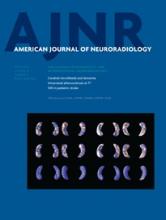Abstract
BACKGROUND AND PURPOSE: Little is known about the pathogenetic mechanism of impaired consciousness following subarachnoid hemorrhage. Using diffusion tensor imaging, we attempted to investigate the presence of injury of the lower portion of the ascending reticular activating system between the pontine reticular formation and the intralaminar thalamic nuclei, and the relation between this injury and consciousness level in patients with SAH.
MATERIALS AND METHODS: We recruited 24 consecutive patients with spontaneous SAH following aneurysmal rupture and 21 healthy control subjects. Consciousness level was rated by using the Glasgow Coma Scale. Using diffusion tensor tractography, we reconstructed the lower portion of the ascending reticular activating system between the pontine reticular formation and the intralaminar thalamic nuclei. Values of fractional anisotropy, apparent diffusion coefficient, and tract number of the ascending reticular activating system were measured.
RESULTS: A significant difference in the tract number was observed between the patient and control groups (P < .05); however, there was no significant difference in terms of fractional anisotropy and apparent diffusion coefficient values (P > .05). In addition, regarding the tract number of the patient group, the Glasgow Coma Scale showed strong positive correlations with the tract number on the more affected side (r = 0.890, P < .05), the less affected side (r = 0.798, P < .05), and both sides (r = 0.919, P < .05), respectively.
CONCLUSIONS: We found injury of the lower portion of the ascending reticular activating system between the pontine reticular formation and the thalamus in patients with SAH. In addition, we observed a close association between injury of the lower portion of the ascending reticular activating system and impaired consciousness in patients with SAH.
ABBREVIATIONS:
- ARAS
- ascending reticular activating system
- FA
- fractional anisotropy
- GCS
- Glasgow Coma Scale
- © 2015 by American Journal of Neuroradiology
Indicates open access to non-subscribers at www.ajnr.org












